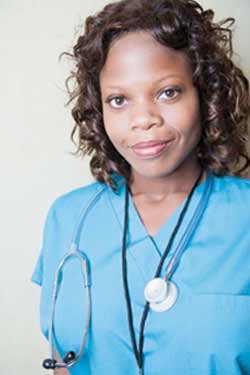From the Heart
Getting the pulse
Editor’s note: Laura Haywood-Cory of Durham wrote this letter to Carolina Woman because February is American Heart Month.
Although Laura’s situation is rare, her story will touch your heart and inspire you to take care of yours.
Stats about women and heart disease follow.
Dear Carolina Woman:
My name is Laura Haywood-Cory. I live in Durham. Last March, at the age of 40, with no family history and no risk factors, I had a heart attack.
In the spring of 2009, I was training for a super-sprint triathlon. I’d had a complete physical a few months prior and everything was great — I’m not diabetic; I don’t have clogged arteries; I don’t have high blood pressure. I’d started a diet/exercise plan several months earlier and had already lost around 20 pounds.
On the morning of March 30, I woke up with textbook heart attack symptoms: chest pain that ran down my left arm and up into my jaw; I felt overheated; and I was about to throw up.
My husband drove me to the emergency room, where they drew blood, took a chest X-ray, did an EKG, and gave me an aspirin and a nitroglycerin patch. They did all the correct things for someone having a heart attack, but all day they were telling me, “We don’t think you’ve had a heart attack: you’re the wrong age, the wrong sex, you don’t have a family history, and all of your initial tests are negative.” They talked about acid reflux, or esophageal spasms.
Then the elevated cardiac enzymes showed up on the second round of blood work, and the ER doctor, who’d decided to admit me overnight “for observation, just in case,” looked poleaxed when he gave us the news.
He said, “I would’ve put your odds of having had a heart attack at much lower than 1 in 100, but the cardiac enzymes don’t lie. You have indeed had a heart attack.”
A cardiac catheterization the next day revealed the culprit — a rare thing called a spontaneous coronary artery dissection (SCAD). SCADs are like lightning strikes; there’s nothing you can do that causes them and no way to prevent them.
They happen more often to women than to men, and most often to young women who are either pregnant or who have just given birth. I belong to the “idiopathic” category, meaning they really have no idea why it happened. (I wasn’t pregnant and, in fact, have no children.)
Essentially, my right coronary artery was shredding. They repaired it with six stents and sent me on my way, after a few more days in the hospital.
I was referred for cardiac rehab (which a lot of women aren’t, despite its well-documented positive effect on healing from a heart event) and completed the 12-week program at the end of July, with blessings from the staff and my cardiologist to get back to my own exercise program.
Being sent home with a pat on the head, and being told that SCADs are really rare and that I’m lucky to have survived it, wasn’t particularly helpful.
I researched my condition and found WomenHeart’s online support group (www.womenheart.org), where I met other women who’d had SCADs and not only survived but thrived. It was a wonderful feeling to know I wasn’t such a freak of nature after all, and I credit WomenHeart, plus cardiac rehab, as being two of the most important pieces of my healing process.
As I’m sure you know, for every woman who dies from breast cancer, five die from heart disease.
So not only for myself, but for the other 40 million women in the U.S. who are living with or who are at risk for heart disease, I’d like to ask that you please feature National Wear Red Day on Friday, Feb. 5, and American Heart Month in February, to highlight the fact that heart disease is the No. 1 killer of women in the U.S.
Best wishes,
Laura Haywood-Cory
Durham
Getting the Pulse: Women & Heart Disease
Prevalence: 
• Worldwide, 8.6 million women die from heart disease each year, accounting for a third of all deaths in women.
• 8 million women in the US are currently living with heart disease; 35,000 are under the age of 65. Four million suffer from angina.
• 435,000 American women have heart attacks annually; 83,000 are under age 65; 35,000 are under 55. The average age is 70.4.
• 42% of women who have heart attacks die within 1 year, compared to 24% of men.
• Under age 50, women’s heart attacks are twice as likely as men’s to be fatal.
• 267,000 women die each year from heart attacks, which kill six times as many women as breast cancer. Another 31, 837 women die each year of congestive heart failure, representing 62.6% of all heart-failure deaths.
At-Risk:
• 71% of women experience early warning signs of heart attack with sudden onset of extreme weakness that feels like the flu — often with no chest pain at all. Medical professionals are challenged to respond to women’s milder symptoms, acting with insufficient guidelines.
• Nearly two-thirds of the deaths from heart attacks in women occur among those who have no history of chest pain.
• Smoking, diabetes and abnormal blood lipids erase a woman’s estrogen protection.
• Women who smoke risk having a heart attack 19 years earlier than non-smoking women.
• Women with hypertension experience a risk of developing coronary heart disease 3.5 times that of females with normal blood pressure. High blood pressure is more common in women taking oral contraceptives, especially in obese women.
• Women with diabetes have more than double the risk of heart attack than nondiabetic women. Diabetes doubles the risk of a second heart attack in women but not in men. Diabetes affects many more women than men after the age of 45.
Compared to Men:
• Men’s plaque distributes in clumps whereas women’s distributes more evenly throughout artery walls. This can result in women’s angiographic studies being misinterpreted as normal.
• Women wait longer than men to go to an emergency room when having a heart attack and physicians are slower to recognize the presence of heart attacks in women because “characteristic” patterns of chest pain and EKG changes are less frequently present.
• After a heart attack, women are less likely than men to receive beta blockers, ACE inhibitors and aspirin — therapies known to improve survival. This contributes to a higher rate of complications after heart attacks in women, even after adjusting for age.
• 38% of women and 25% of men will die within one year of a first recognized heart attack.
• Women are twice as likely as men to die within the first few weeks after suffering a heart attack.
• 46% of female and 22% of male heart-attack survivors will be disabled with heart failure within six years.
• Women are two to three times as likely to die following heart bypass surgery. Women between the ages of 40 and 59 are up to four times more likely to die from heart bypass surgery than men the same age.
• Studies show women who are eligible candidates to receive life-saving clot-buster drugs are far less likely than men to receive them.
• Since 1984, more women than men have died each year from heart disease and the gap between the survival of women and men continues to widen.
• Women comprise only 24% of participants in all heart-related studies.
Source: Women’s Health Foundation



